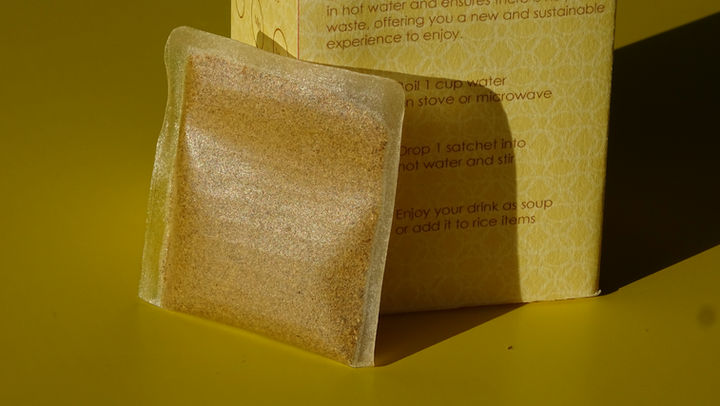Seaweed Packaging
Sep - Dec 2022
As part of the Grad Studio II at RISD in my third semester, I investigated the gaps and opportunities to replace plastics in commercial food packaging. My field research was conducted by interviewing customers and managers at local grocery shops including two Whole Foods stores in Providence, RI. Using these insights, I designed and developed thin biofilms made of locally sourced seaweed, which are dried, powdered and blended with a plant-based binder. This process is used to produce sheets that can be folded, sealed and used as biodegradable, non-toxic, plastic-free alternative for food packaging.
Role
Conducted research on existing products, formulated and designed an approach to create seaweed films, and experimented with consumer applications in food.
Areas of Focus
Biomaterial Design
Product Design
Sustainable Design
Packaging Design
Customer Research

Plastic Problem
Each year, over 380 million tons of plastic are produced globally, with up to 40% used for packaging alone—most of it discarded after a single use. Food packaging, particularly, is a major contributor to this crisis due to the widespread use of multi-layered plastics like polyethylene (PE), polypropylene (PP), and polyethylene terephthalate (PET), which are designed for durability but resist decomposition in nature. These materials often break down into microplastics, which have been detected in over 90% of bottled water and even in human blood, raising serious health concerns. Multi-layer laminates used for sachets, condiment packs, and frozen foods are nearly impossible to recycle due to their composition. The persistence of these plastics in landfills and oceans point to the urgency of developing biodegradable, non-toxic alternatives—especially for single-use applications in the food industry.

Img.1 Different types of plastic and other waste contaminating a water body.
Customer Research
To ground the project in real-world needs, I conducted field interviews with over 20 customers and staff at grocery stores in Providence, including Whole Foods Market on North Main Street and Waterman Street. The conversations revealed a growing consumer consciousness around packaging waste: 85% of customers expressed concern over plastic use in food packaging, and more than half said they would pay 5–10% extra for a truly compostable or plastic-free option. Grocery managers echoed this demand, noting that sustainable packaging could be a key differentiator, especially for health-conscious shoppers and eco-conscious brands, and brought up durability as a key factor for adoption. These insights validated the opportunity space for new packaging materials that are safe, scalable, and aligned with zero-waste values.

Img.2 Conducting interviews at Whole Foods store in Providence, RI.

Sketch.1 Mapping the service ecosystem around sustainable food.
Biomaterial Design
The material innovation began with a natural, abundant marine resource: seaweed from Narragansett Bay. After collecting and identifying suitable species of green algae, the seaweed was thoroughly washed to remove salt and organic debris, then dried and ground into a fine powder. The powder was blended with food-grade glycerin as a plasticizer and a small amount of starch to improve mechanical integrity. This formulation was cast into thin films (0.2–0.4 mm thick) using a heated press and silicone molds. These biofilms are non-toxic, edible, and dissolve in hot liquids, making them uniquely suited for single-use food applications. The iterative design process involved over 15 trials to refine texture, flexibility, and dissolution properties.

Img.3 Collecting seaweed samples at Naragansett Bay.
Fig.1 Biomaterial design, properties, constraints and ingredients.
Img.4 Biomaterial experiment setup and equipment at the RISD Nature Lab.
Packaging Prototypes
The biomaterial films were used to prototype a variety of packaging forms that cater to different use cases. Early concepts included sealed tubes for liquids, cylindrical wraps for dry ingredients, and flat sachets for instant beverage powders or spice blends. Design exploration focused on ease of sealing, dissolvability, and minimal material usage. I also explored embossed patterns and QR-embedded stamps to communicate ingredient transparency and user instructions. The goal was to prove that sustainable packaging can also be functional, brandable, and delightful to use, while remaining fully compostable or even consumable.

Img.5-15 Concept prototypes for different forms and applications of seaweed packaging.
Fig.2 Process for selecting concepts and iterating toward the final product with an outer paper packaging.
Final Product
The final product is a dissolvable seaweed-based film pack specifically designed for Rasam, a traditional Indian herbal drink. The packaging encases a concentrated spice and herb mix and is intended to be dropped directly into hot water, where it dissolves completely within seconds. The film leaves no residue, odor, or off-taste, and dissolves uniformly without clumping. Custom formulations allow for the integration of turmeric or neem extracts for added antibacterial and preservative qualities, opening possibilities for both functional and extended shelf-life applications. The format is especially suited for single-serving packs, such as airline meals, camping rations, and medicinal teas.

Img.16-22 Final product 'Rasam' with 8 bags of dissolvable seaweed packaging to make a herbal drink.
Multimedia and Communications Plan
Balancing creative writing with technical information was done in parallel with the assisting the design team with layouts, visual graphics, imagery and interactions. The communications strategy and website were refined, tested and launched in June 2024.

Outcome
This project is a response to the growing need for circular design practices in the food industry. Through local research, material prototyping, and sustainable design principles, I created a working prototype of plastic-free, edible packaging using seaweed. These findings were shared with the community at Brown University and Rhode Island School of Design at the BRIC Talks in 2022. The project demonstrates how regional biomaterials can replace petrochemical plastics in niche yet scalable applications. Beyond Rasam, there is potential for a platform of formulations for condiments, supplements, spices, and more—offering low-impact, zero-waste solutions that consumers trust and brands can own. It represents a small but meaningful step toward rethinking the lifecycle of food packaging, rooted in place, purpose, and planetary care.

Img.23-24 Presenting the work in Prov Wash auditorium for a talk at Brown-RISD Innovation Community.




















